grad505-mathewhocking
40 posts
GRAD505 - Design Research
Don't wanna be here? Send us removal request.
Text
WEEK 12 REFLECTION
This week we continued working on our essays. I collected more material from the library and have managed to finalise my essay this afternoon. My next step is to take it into TurnItIn and make sure it is ready for submission.
This research project has helped me form some valuable knowledge in regards to academic integrity, locating source material, extending my resources beyond the computer, and locating my own opinion amongst a vast range of texts. Looking into the history of New Zealand design has really helped me understand the richness of our country and also our stance in design as a nation.
Some things I would like to work on in the future include time management and better writing techniques. Overall I really enjoyed this project and hope to have the chance to investigate a range of other design practices in the future.
0 notes
Text
IMAGES FOR ESSAY
The final images I will include in my essay where references will be attached.
Interior design advertisement, late 1950s
This image will be used alongside my introduction. It gives a good indication of the trends which was being pushed at the time. It also addresses the gender roles which were very apparent in family living.

Wassily Chair designed by Marcel Breuer
This image will be used alongside my 1st paragraph where I discuss the origins of the modernist movement, specifically the Bauhaus and Scandinavian design. This is the iconic Wassily Chair designed by Marcel Breuer in 1925 and gives great context to the style and execution of modern furniture design.

Display of Jon Jansen
This image will be used alongside my 2nd paragraph where I discuss NZ modernist design and its various leading figures. Jon Jansen was a contemporary furniture store in Auckland. The lowercase sans serif font for the shop front is very in line with the modernist aesthetic. The name comes from founder Lincoln Laidlaw, who invented the name Jon Jansen to invoke a Scandinavian style.
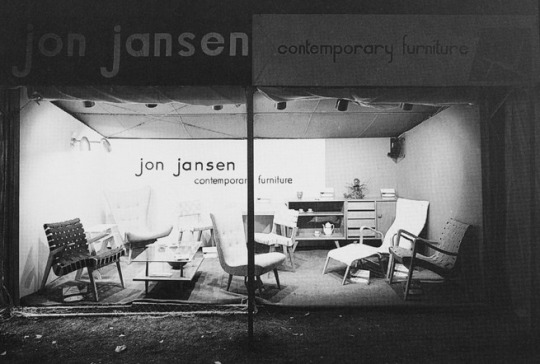
Design Review: Volume 3, Issue 1 (July-August 1950)
This image will be used alongside my 3rd paragraph where I discuss the significance of how modernist design was communicated to the New Zealand public in the 1950s. Design Review was a popular publication which advocated for the principles of modernism across all mediums.
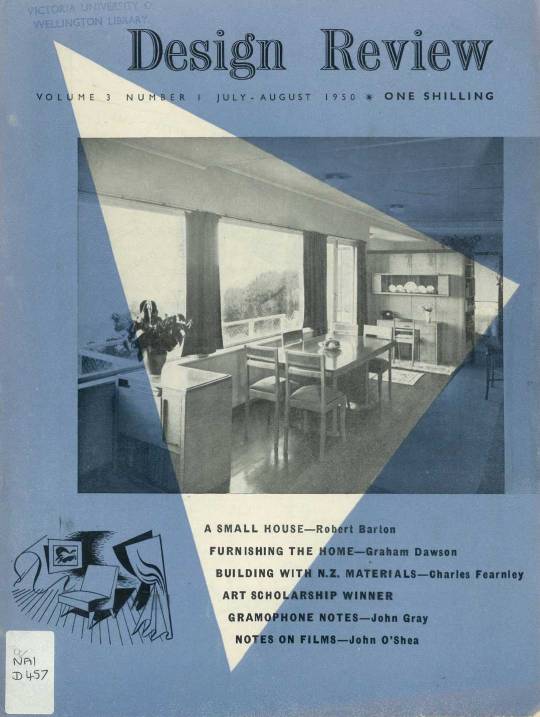
John Crichton Information Sheet from the late 1950s
This image will also be used alongside my 3rd paragraph. It is an information sheet which illustrates the importance Crichton placed on modern lighting for the home. It is a great way to see how homes were being styled as well as the graphic design style it favours.

1 note
·
View note
Text
COLLECTING RESEARCH
A few more books I have issued out from the AUT Library this week to assist with my essay.
Modernist Design Complete by Dominic Bradbury
This has been an excellent resource in learning more about the origins of modernism as well as modernist furniture. My first paragraph topic explores the origins of modernism, what it meant, and who was at the forefront, so it has given me some great content to develop on.

Design Directory: Scandinavia by Bernd Polster
This book looks at the modernist work of Scandinavian artists. It has a really rich archive of furniture and products for the home and has helped me see where some of the inspiration for NZ artists in the 1950s came from.

At Home: A Century of New Zealand Design by Douglas Lloyd-Jenkins
This is probably one of the most in-depth publications on the history New Zealand homes by leading architect and designer Douglas Lloyd-Jenkins. There is an entire chapter dedicated to the 1950s modernist movement which has informed a lot of my discussion in my second paragraph looking at NZ modernism, who, what, and the comparison of this movement compared to tradition.
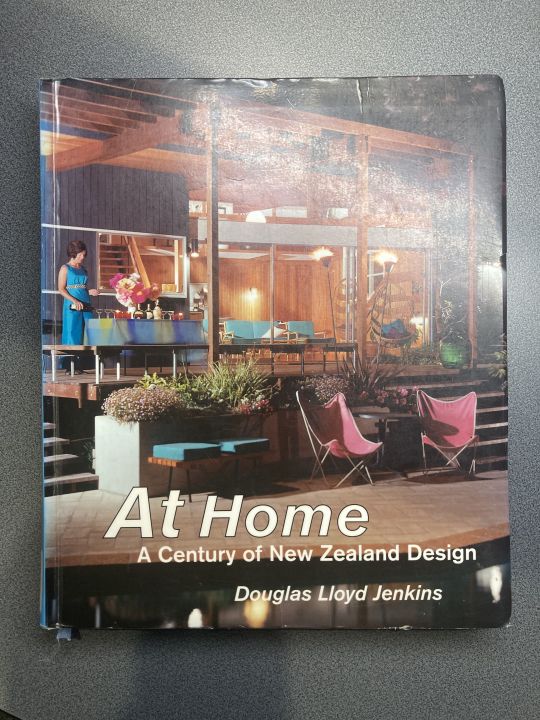
The Bauhaus Ideal Then and Now: An Illustrated Guide to Modernist Design by William Smock
This book explores the history of the Bauhaus. I found this useful as the Bauhaus has influenced many designers of the 1950s and the principles of it still very influential today.

0 notes
Text
COLLECTING RESEARCH
I found this article that explores New Zealand modernist design. I highlighted some key information that will assist with my writing. At this stage, I’m familiar with most of the designers and business’ mentioned, but it does have some relevant points about certain influences, practices and ideas.
http://modernmag.com/kiwi-cool-design-from-below-the-equator/
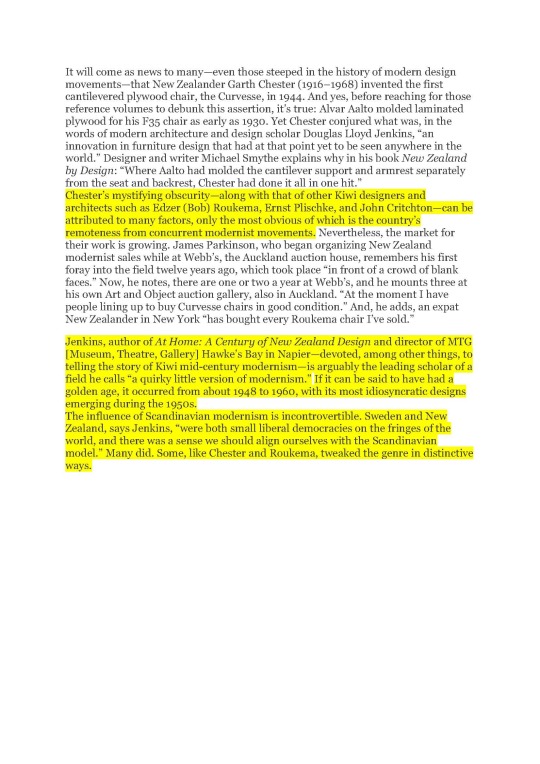


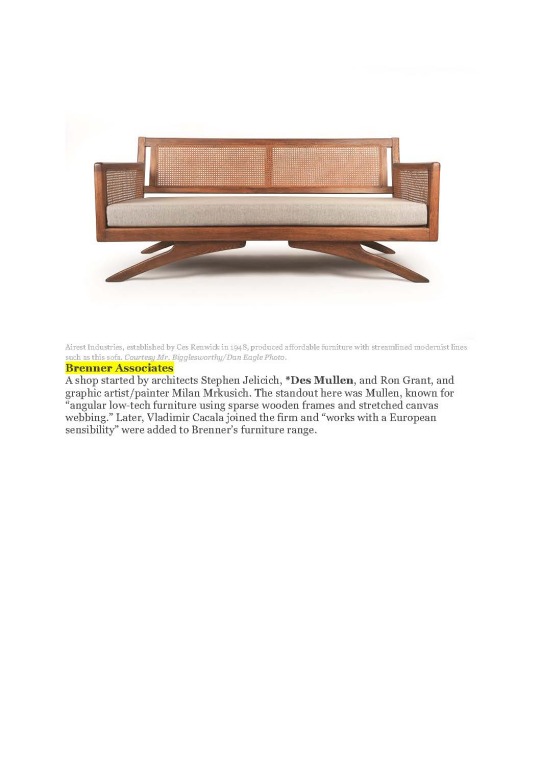
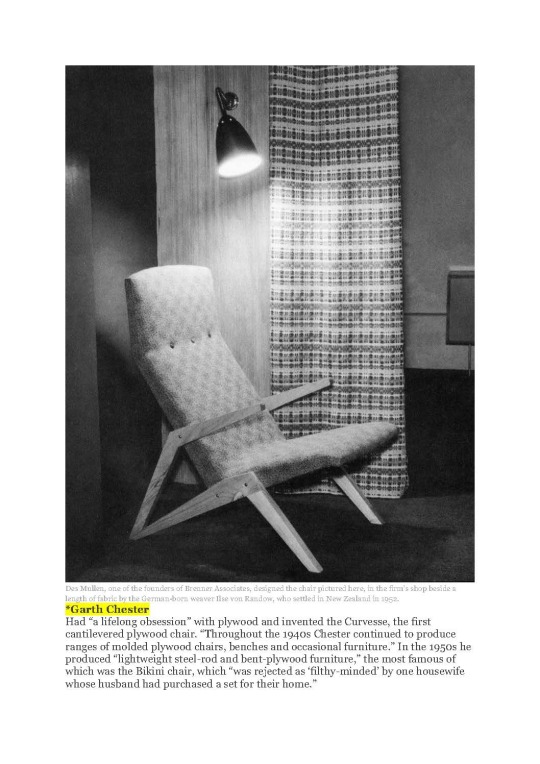

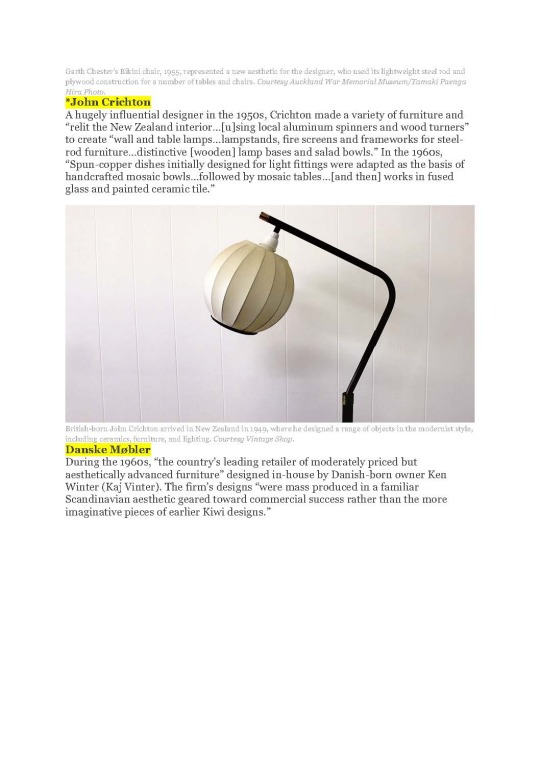

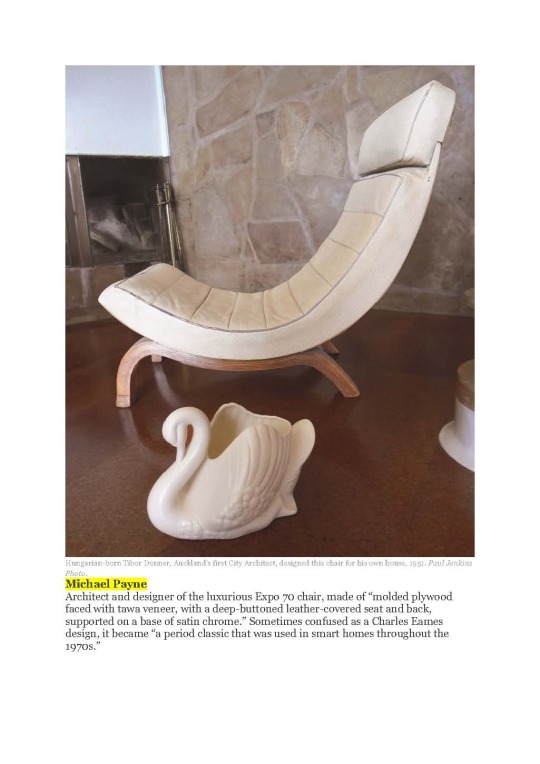
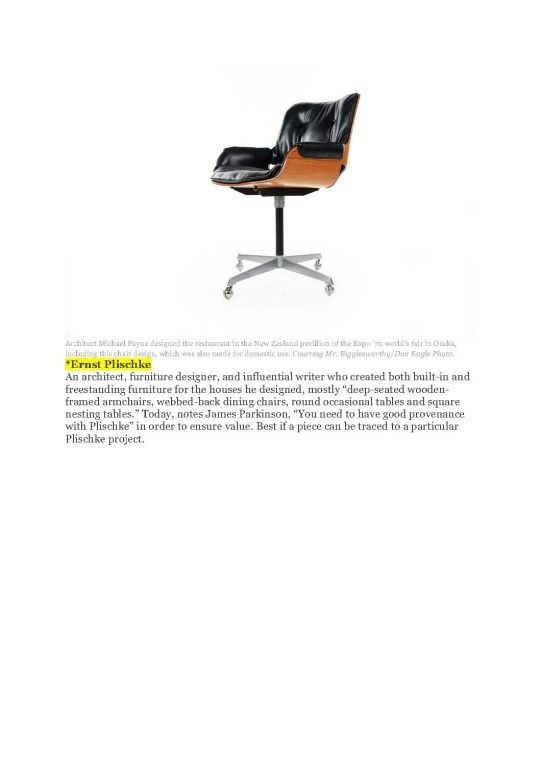
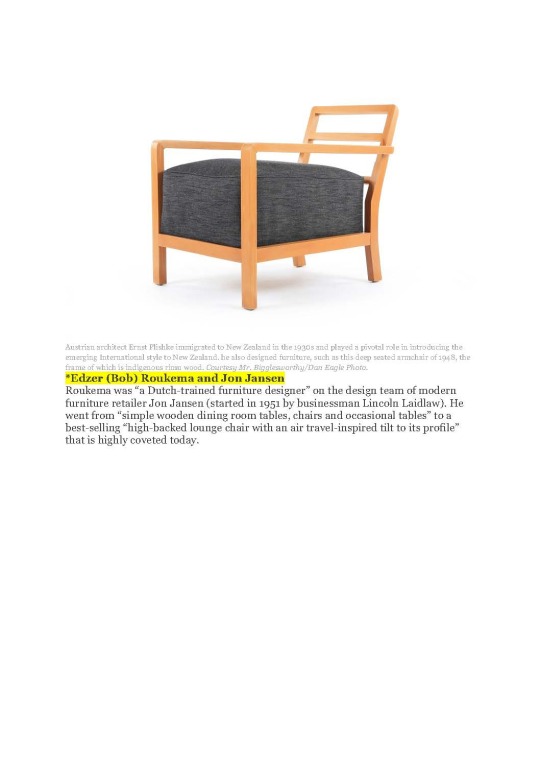

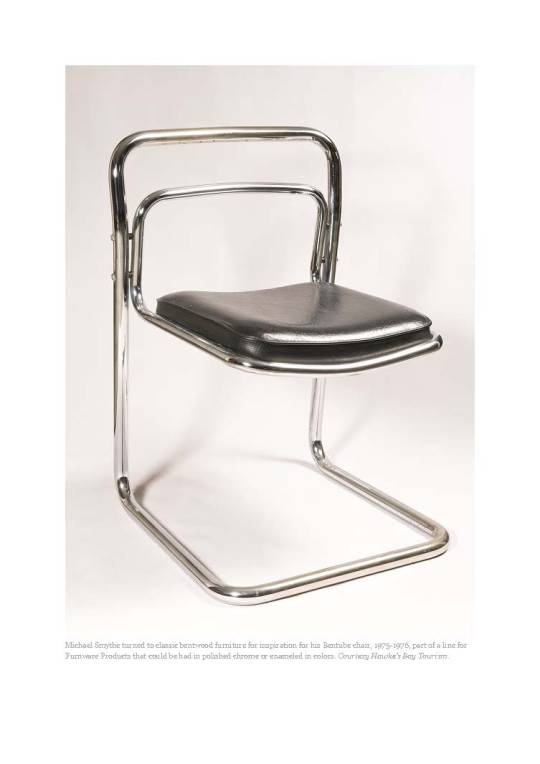
0 notes
Text
WEEK 11 REFLECTION
This week was all about discussing progress amongst each other. We introduced our topics and main points to the class and then broke off into pairs which best reflected the amount of work we had each done. I partnered up with Kevin who is researching punk culture in the UK during the 70s and we gave each other some feedback on the writing we had done so far. Both of us had only done an introduction/paragraph 1 so there wasn’t a lot of work to go off but it was still very helpful. As someone who is a fan of punk and punk music, it was great to see some of the things Kevin had been researching. He didn’t have much to comment on re my progress so I think that is a good sign.
I got to have a conversation with Becky as I was wanting some confirmation on whether or not I was heading in the right direction. Because my topic is not so much based on ‘visual communication’ I needed to see if it would translate well enough to meet the brief. We had a great discussion about some of the designers, products, movements and magazines of the time both in New Zealand and abroad. Something I had not considered before this was IKEA and looking at how this brand has brought the Scandinavian aesthetic of early/mid century modernist furniture into an everyday and accessible market around the world, but is actually not even available in New Zealand today. Although we have been promised an IKEA store for quite some time now, it has still not happened, which almost goes against the whole idea of modernist furniture being accessible to the every day person. And this would not be so strange if we didn't have a history of modernist practices happening here, it’s been happening here since the 40s! We then questioned what stores we do have and places like Danske Mobler and Citta, who certainly fall into this category, veer off into the realm of luxury. So the main topic of our conversation ended up trying to understand why, here in New Zealand, we don’t have equal access to these products which are really based off the utopian model of better living. We also looked at Garth Chester’s curvesse chair and questioned whether the essay could primarily focus on that but came to find out that there wasn’t enough information re the advertising/marketing of this product. There was a lot to think about and it was very helpful to have such a great perspective on this.

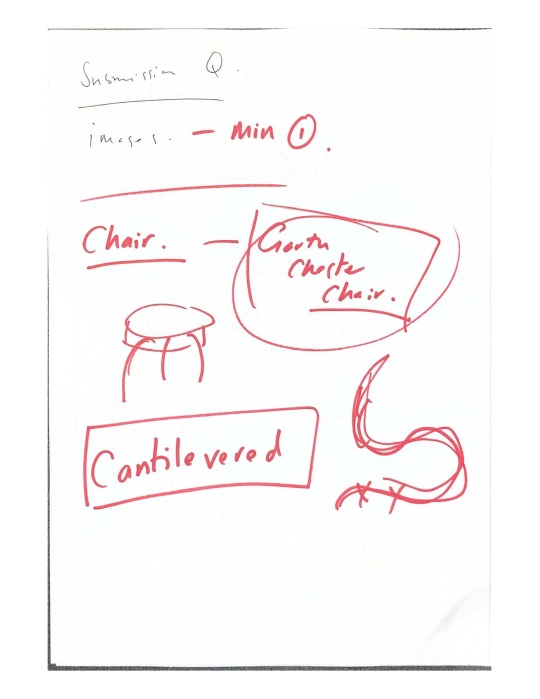
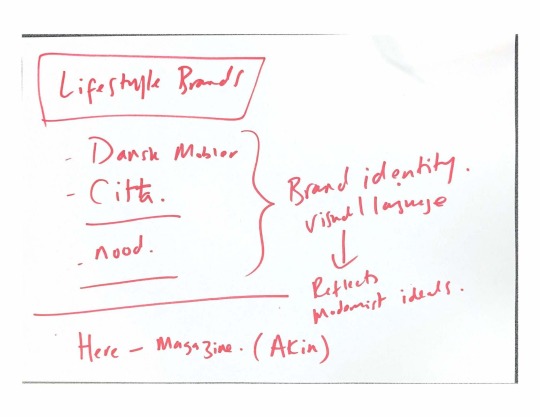

The class was then reintroduced to the brief and what was expected for submission on the 7th of June. At this stage we’re expected to keep writing and researching. We should be focused on getting the essay done, making sure our referencing is of standard, and having our blogs kept up to date.
0 notes
Text
NEW ESSAY FORMAT
New essay format. I decided to switch my first two paragraphs around as I feel like it makes more sense. Paragraph 1 will introduce European modernism in product/furniture design and paragraph 2 will follow on to explain how this movement influenced NZ design in the 1950s. The third paragraph will then focus on the way this new lifestyle was advertised, the public response, target audience and influence/impact on the traditional culture of the time.
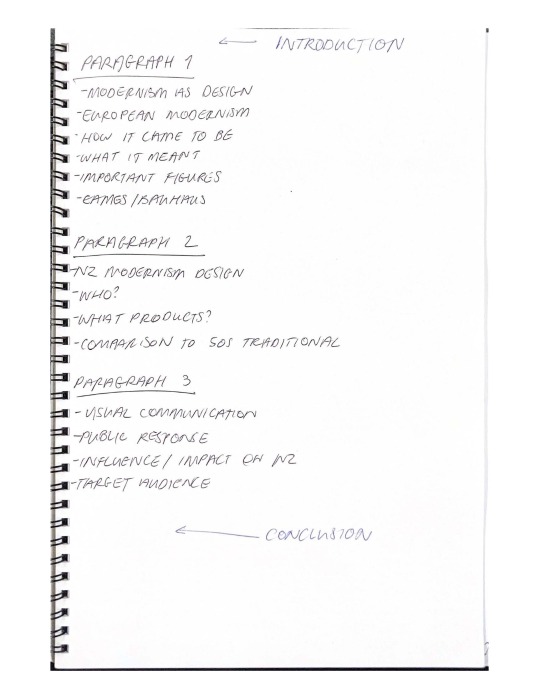
0 notes
Text
COLLECTING RESEARCH
I issued this book out from the AUT Library which covers all areas of modernist design. It's called ‘Modernist Design Complete by Dominic Bradbury’. I chose this book because one of my paragraphs (most likely the first) will be addressing European modernism, how it came to be, what it meant, pre and post war practices (venture into mid-century), and the important/leading figures. I think this is an important subject to cover as it will help give a better understanding to what actually influenced NZ designers and the European designers who immigrated here during the 1950s.
I found this section very helpful in understanding the origins of modernism and the overall ethos of this design movement. I went through and highlighted sections which could help assist me in writing my essay. This meant ignoring minor details such as specific furniture pieces or other international designers.
Key
Blue - important text
Yellow - important names
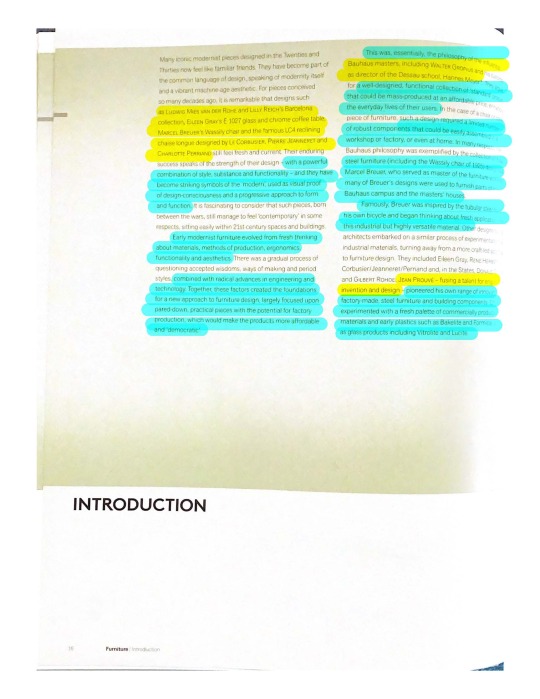
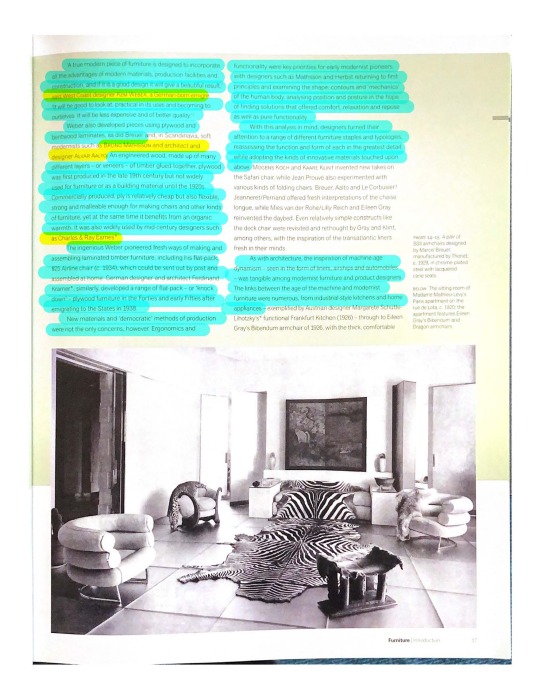
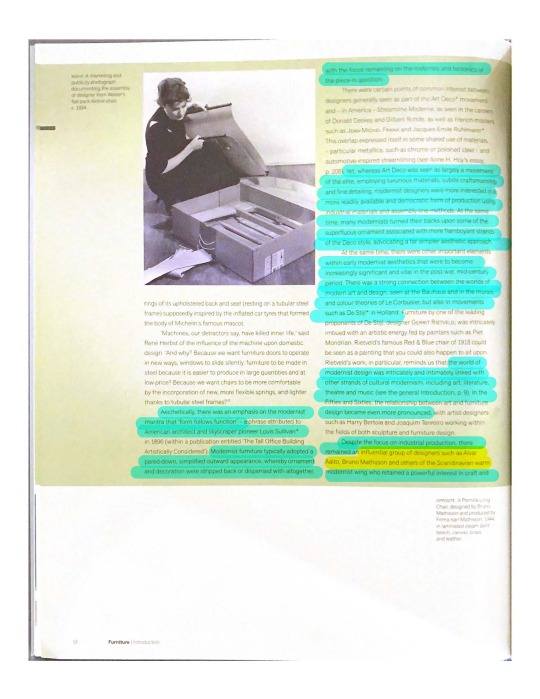
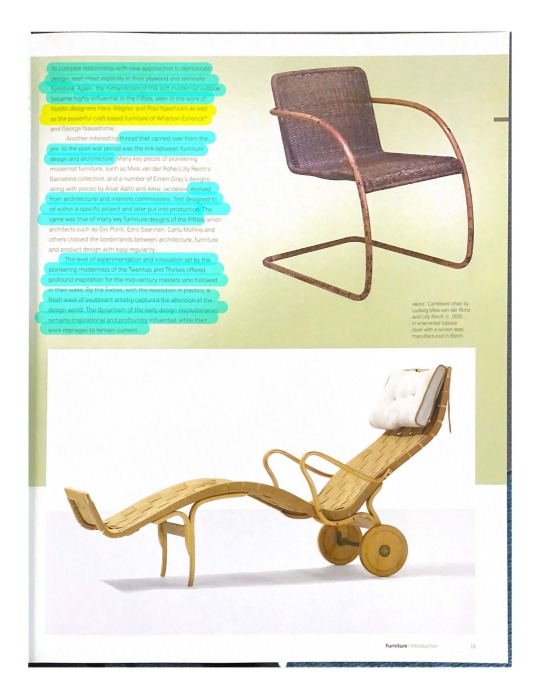
0 notes
Text
COLLECTING RESEARCH
I found this short video on YouTube which gives some detail into an iconic piece of modernist furniture produced by John Crichton in the 1950s here in New Zealand. It explains how pieces like this are a great example of how a new way of living started to emerge during this time. This light featured in the 1952 "Modern Living” exhibition and was recreated by the designers at Te Papa. They were unsuccessful in finding an original so it was produced based off a photograph by Frank Hoffman.
youtube
0 notes
Text
WEEK 10 REFLECTION
“Let us strive for, conceive, and create the new building of the future that will unite every discipline...” - Walter Gropius, Bauhaus Manifesto
Due to being sick with what was suspected to be covid (but thankfully was not) I was unable to attend class this week, however I did manage to catch up on the lecture via MS Teams and the SDL tasks via Canvas. I unfortunately did not find much time to complete a lot of work this week because I was sick but I did manage to write a draft introduction.
In the lecture, Becky introduced us to the history and importance of the Bauhaus. As someone who is quite fond of modernism, this was a very enjoyable lesson.
The Bauhaus was founded by architect Walter Gropius in Weimar in 1919 and was influenced by William Morris’ socialist principles. He believed in the unification of art and design (as these were seen as two different things at this time), that good design should be accessible to everybody, and that there should be a place for people from all walks of life to create and experiment with a focus on community. The Bauhaus was only active for 14 years, up until 1933 when its operations came to a close, which is quite remarkable to think about considering the influence it had (and still does) on the world. During its time, along with working very hard, the students and staff would put on very theatrical parties and performances, they played with gender identity, and was overall thought to be rather ‘outrageous’ to the general public.
The curriculum for the school was something that had not been seen before. Students would do a 6 month preliminary course to de-learn/re-learn tradition, followed by a 3 year workshop course which would see the more talented students find work as assistants in Gropius’ office, and finally having the opportunity to become a master/teacher at The Bauhaus.
There was an exercise in this lecture which required assigning the three primary colors (yellow, blue, red) to a circle, triangle and square, based off Wassily Kandinsky’s form + colour teachings where he believed in a universal visual language. Kandinsky, alongside Paul Klee, ran a workshop within the preliminary course at the Bauhaus. My personal interpretation, before learning Kandinsky’s, came from this marriage of the name of the colour and the form of the shape, so:
The triangle is yellow - sharpness of both the shape and letter forms in ‘yellow’ The circle is blue - the softness of the circle form and the ‘serene/calm’ symbolism of blue (which ‘blue’ also has this organic roundness to it) The square is red - the rigidness of the shape and blockiness of the word ‘red’
Unfortunately, for all of Gropius’ progressive beliefs, he thought that women's minds were different to mens, therefore othering them in the school, which is such a shame to hear. In the beginning, 51% of the students were women and they were only allowed to advance to workshops in textiles and weaving, so it’s super frustrating to hear about this kind of sexism happening in a place that you’d think would be the complete opposite. Annie Albers became the head of weaving in 1930 at The Bauhaus and is a well known artist from this period. Marianne Brandt defied any of these notions and pursued a metalwork practice, eventually becoming an assistant and one of the most successful Bauhaus students (so cool!!)
The SDL for this week is to continue writing our essays so that we have a full draft in time for next weeks lesson.
1 note
·
View note
Text
DRAFT INTRODUCTION
1950s New Zealand is often referred to as the ‘golden age’ in our history books. World War II came to an end, a shift in culture and morals was becoming evident, and our ties to British tradition were gradually loosening up. It was a time of both optimism and uncertainty. Previously, our geographical location caused a halt in our trajectory towards more refined design practices, however, due to an influx of European migrants during this decade, New Zealand would come to see a strong essence of modernism growing throughout. Many people arriving in the country were looking at New Zealand as their new home, and so, needed furnishings and products which helped reflect their class, identity, culture, and perspective. Gender roles still remained conservative, with men returning home to be the head of the household and sole provider, while woman were expected to be the homemaker who cared for the children – a very universal dynamic in the Western world at this time. By way of new technology and curriculum, aspects of a more European approach towards products for the home would make this lifestyle still more accessible for the urban citizen via magazines and advertisement. The idea was to move New Zealand into the framework of appreciating modern, accepting modern and, therefore, living modern. This essay will explore how immigration in the 1950s from Europe to New Zealand influenced product design for the home and how this new lifestyle was communicated and sold through graphic design and visual communication.
0 notes
Text
WEEK 9 REFLECTION
This weeks lecture we looked at various art movements that happened in Russia during 1910-1930, primarily The Ballet Russes and Constructivism.
We also learnt a bit about the Coronation Disaster (1986), the Russo-Japanese war and financial crisis (1904-1905), Russian culture in Paris, Futurism and Suprematism. Some key figures mentioned were Vsevolod Meyerhold, who’s theory was you do something and then feel something, and Stanislavski, who believed rather you feel something and then do it. We also looked at Rasputin, who was an influential figure of the time due to his self-proclaimed healing abilities, and he would have quite a big impact on society as many people believed him to be the devil or the anti-christ.
In class we worked in groups to meet and receive feedback on our progress so far. I worked with another student who was researching in a similar field (architecture in the 1950s) and we both found that our interest in these physical objects was somewhat of a crux in our progress because we were both struggling to find material around how these practices were visually/graphically communicated and sold. Something interesting that came from our conversation was this idea of comparing products or buildings to the modernist style of graphic design in the 1950s, so when European designers were favouring sans serif fonts over serif fonts and clean, asymmetrical layouts, you could see that same sense of reduction in some architecture of furniture.
For our SDL task this week we are to continue researching and writing in our MS Teams draft submission document, find 2 physical resources to bring to class on Thursday and continue posting on our blogs.
0 notes
Text
DESIGNER PROFILES
To help myself better understand the leading figures in modernist design during the 1950s in New Zealand, I created some profiles of their work. I have done this due to the fact that there have been quite a few terms and names being used in the research I’ve found and so I looked to this exercise to help formulate everything.



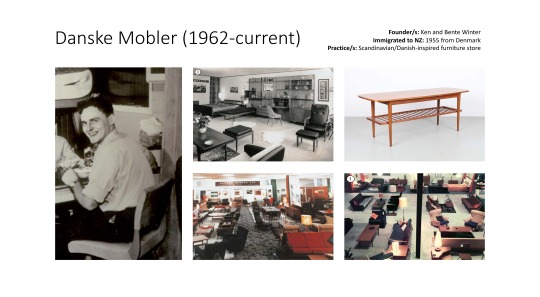


References
https://en.wikipedia.org/wiki/Ernst_Plischke
https://en.wikipedia.org/wiki/John_Crichton_(designer)
https://en.wikipedia.org/wiki/Garth_Chester
https://danskemobler.co.nz/our-story
https://mrbigglesworthy.co.nz
http://nzdesignhistory.blogspot.com/2013/09/29-steps-to-modernity-new-zealand.html
0 notes
Text
IMPLEMENTING CHANGES
As part of the SDL task from week 8 we were to expand our research based on the formative submission and feedback. Using the template provided I considered my main idea, an essay structure brainstorm, and the 3 topics I will discuss with supportive imagery and evidence.

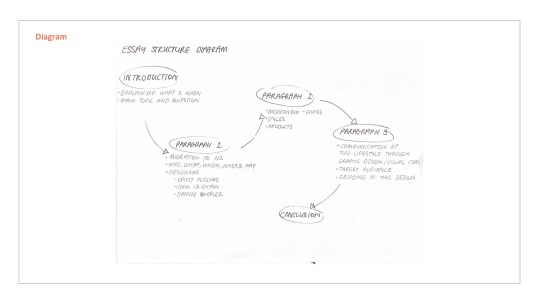

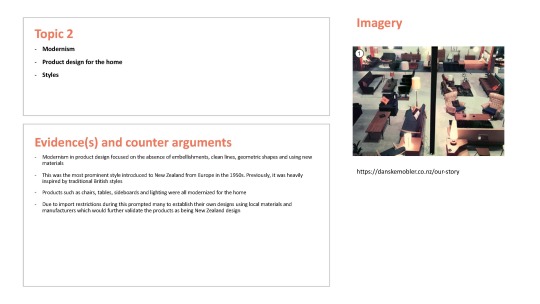
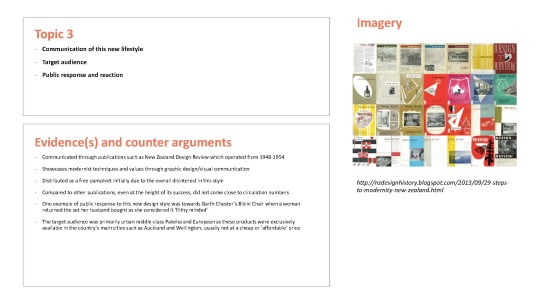
0 notes
Text
WEEK 8 REFLECTION
Due to a family emergency earlier in the week I unfortunately had to miss both classes, but was able to catch up on what I missed through Canvas.
In the lecture this week we learnt about Mātauranga Māori with Toiroa Williams. Mātauranga Māori is Māori knowledge, knowledge that has been passed down from our ancestors, such as the Māori world view and perspectives, Māori cultural practices and creativity. Throughout the pacific we are all connected as we share common ancestors but all have our own unique cultural practices and dialects.
The principles of Oceanian Design:
1. Kawa - the principles our people lived by, for example Te Reo Māori, what we do
2. Tikanga - the protocols and procedures how we speak the language (dialects, difference in words or meanings), how we do it
3. Mana - spirituality, everyone and everything has mana, prestige, power
Tangaroa, god of the sea, and Tane, god of the forest, are two of our oldest Whakairo (carving) artists. Surprisingly, Tangaroa was the first carver of wood, a resource used to tell our stories on wharenui, which makes sense when you consider driftwood that emerges from the ocean a new object. A few ways design is shaped in Māori through whakapapa is purpose (why), ownership (who), and craft (what/how), which are all intertwined, ultimately influencing the design that artists will create. There was also a brief introduction to the marae here on campus and Māori design in this context, as well as a short video about the carving school at Te Puia in Rotorua.
Our SDL task for this week was to implement changes based on formative, expand on research and resources, and make sure our blogs are up to date. The feedback I got from Becky was very informative and helpful.
0 notes
Text
COLLECTING RESEARCH
While back in my home town, I visited a few op shops and was able to pick up these two books for only $5. Although the content is not particularly specific to my design practice, they still offer some valuable information in more of a political context. I think it is really important to explore these things when looking at design through a historical lens. The overall theme of both publications is to present New Zealand’s rich history and the variation in lifestyles over the decades.
Looking Back: New Zealand 1900-2005


New Zealand reached a population of 2 million by 1952 - a huge milestone for our small country. This suggests that migration was at an all time high, which certainly had an impact on many industries, including design. In 1956, the erection of new power stations took place due to the growing demand for more electricity. With more homes across the country having electric power, a market for modern appliances for the home would have emerged.

At the beginning of the decade, Crown Lynn begins producing one of their most popular items, a vase, which would find its way into many households across the country. I find this interesting because it suggests that people were beginning to investing in local design while also placing an importance on decorating their homes.
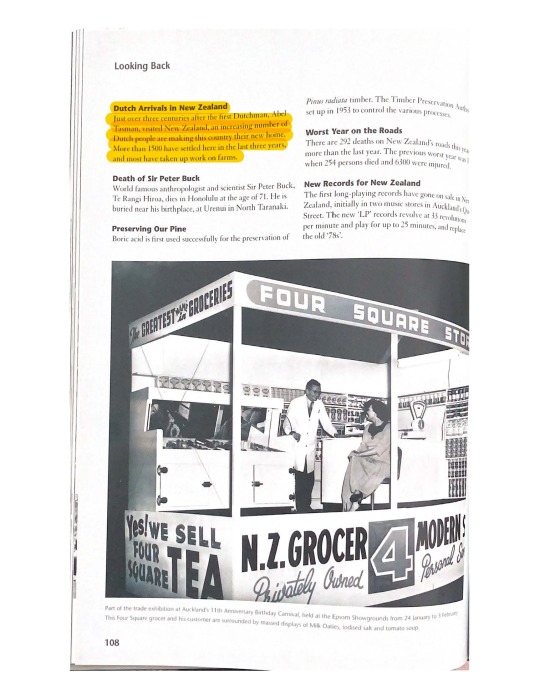
More than 1500 Dutch people settled in New Zealand between 1947 and 1950 and, while a lot of them found work on farms, there may have been some young artists and designers too. The Netherlands has a rich history with modernism, birthing the De Stijl movement in the 1920s, so it’s very possible that some of these ideologies transferred to the New Zealand design scene during this time.
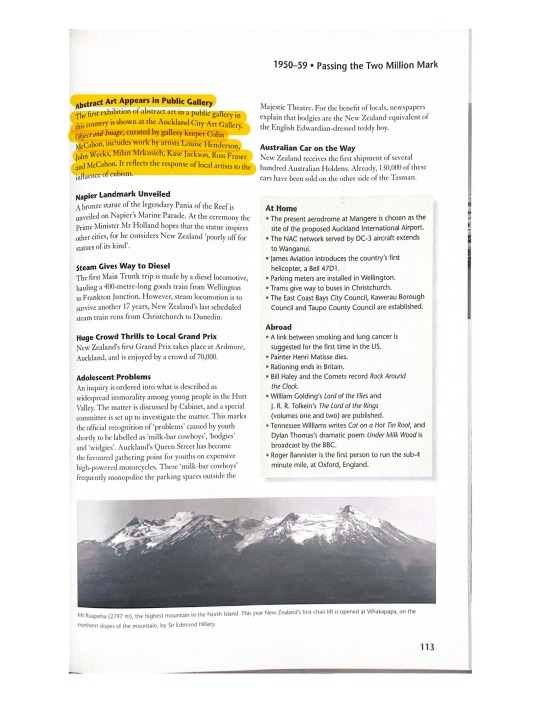
Abstract art is presented to the public for the first time in 1954 by way of an exhibition at the Auckland City Art Gallery. The art was heavily inspired by the cubism movement of Europe and would be a way for local artists to reflect on that, so we are beginning to see art take a more significant position in New Zealand culture.
New Zealand Yesterdays: A Look At Our Recent Past
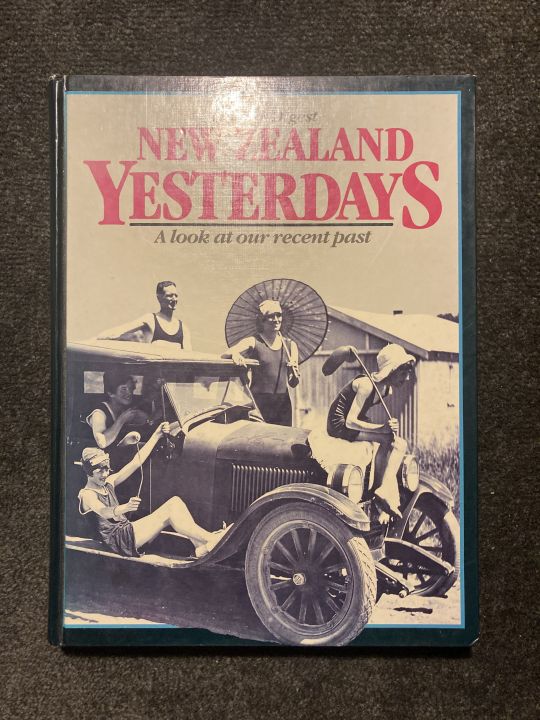

This spread explores the history of furnishing and decoration in New Zealand. There is not a lot of information about the style of the 1950s but I do think it is interesting to see what came before. Something I found interesting is how before plasterboard became popular, the walls of rooms were lined with matchboard which, on a windy day, would billow heavily. Feltex, an inexpensive carpet substitute, was the solution for many families who primarily had linoleum flooring, and this came around just before WWII. Changes to the walls and flooring over the years definitely would have allowed people to be more expressive when decorating their home.
0 notes
Text
COLLECTING RESEARCH
Over the semester break I visited Mr. Bigglesworthy in Ponsonby, a vintage design store that focuses on high quality mid-century modern furniture, art and contemporary design. While browsing on the web for New Zealand designers who were active during the time period I’m looking at, Mr. Bigglesworthy would often come up as a source for images, showcasing some really great pieces alongside a brief history of the maker and their practice. Some of the names include Bob Roukema, Ernst Plischke, Brenner Associates, Garth Chester and John Crichton. Upon my visit, I wasn’t able to see a lot of New Zealand made pieces, but these two were definitely my favourites.
Vintage Mahogany Desk
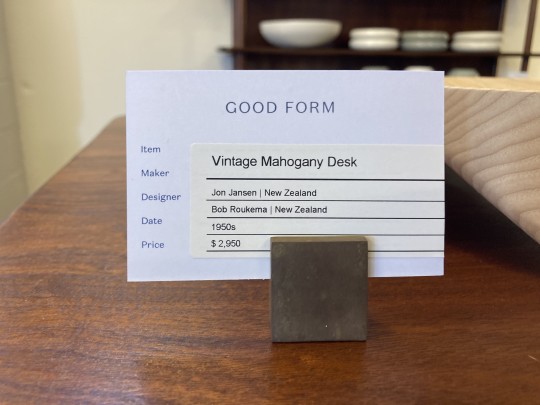


Vintage Woven Rattan Magazine Holder


When I was looking at the Jon Jansen desk, I got talking to one of the gallerists and he mentioned that the man who established the Jon Jansen store actually began in the toy industry, but would later go on to fulfil the demand that was present for modernist furniture. The store closed after 12 years due to the import restrictions, which was a huge factor in the demise of operations in this practice. It was great to be able to talk to someone who showed a real passion for sourcing and restoring such iconic pieces of our history.
It was a great experience to see these designs in person. Amongst many international products, design publications, and the furniture itself, I felt that I got a better understanding of the craftsmanship behind 1950s product design for the home. The shapes and textiles were exactly what I had read about and they definitely paint a picture in your mind of what life was like for some.
0 notes
Text
EXPANDING AND PREPARING
Here are two more images I have found that may be included in my essay.
This is the cover of a Design Review publication from 1950. It features a photograph of a modernist style home set against an illustrative background which speaks to the landscape of New Zealand. This scenario has quite a lot of contrast and definitely amplifies the intention behind modern design. I can imagine it would have been quite exciting to see covers like this at the time, to know these things are possible in a country so far from the rest.
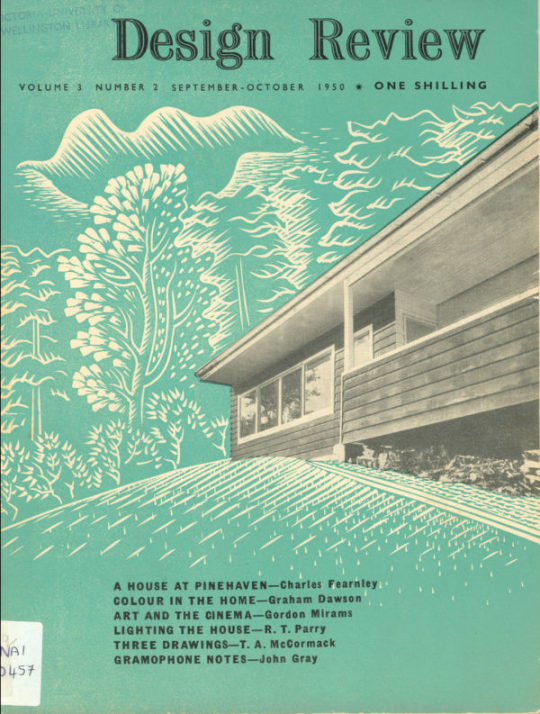
Reference: Design Review 3, no. 2 (September-October 1950)
This is an advertisement poster for Smiths City Market Ltd. in Christchurch. It features clean, contemporary furniture for the bedroom. The influence of European modernism is very apparent here with the built-in furniture, clean lines and shapes, and also the bright colours. Something I find interesting about this advertisement, along with many other commercial designs of the 50s, is the graphic design still feels quite traditional. The typefaces, colours, placements, are all things that don't really speak to the modernist style. Yes, it does have that 50s feel, but compared to European graphic design of the time, it’s too decorative. This could have been due to technological issues or it could have also been a marketing tactic to convince their consumer base to invest in them.

Reference: Real Modern: Everyday New Zealand in the 1950s and 1960s
0 notes